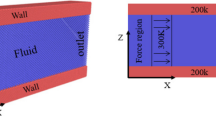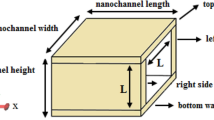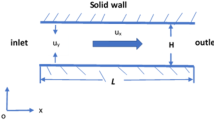Abstract
Non-equilibrium molecular dynamics simulations have been carried out to investigate the effect of surface roughness and interface wettability on the nanorheology and slip boundary condition of simple fluids in a nanochannel of several atomic diameters width. The solid surfaces decorated with periodic nanostrips are considered as the rough surface in this study. The simulation results showed that the interface wettability and the surface roughness are important in determining the nanorheology of the nanochannel and fluid slip at solid–fluid interface. It is observed that the presence of surface roughness always suppresses the fluid slip for hydrophilic and hydrophobic surface nanochannels. For fluids over smooth and hydrophobic surfaces, the snapshots of fluid molecules show that an air gap or nanobubble exists at the fluid–solid interface, resulting in the apparent slip velocity. For a given surface with fixed interface wettability, the fluid velocities increase by increasing the driving force, while the driving force has no significant influence on the density structure of fluid molecules. The fluid slip and the flow rate are measured for hydrophilic and hydrophobic nanochannels. The flow rates in rough surface nanochannels are smaller than those of smooth surface walls due to the increase of drag resistance at the solid–fluid interface. The dependence between fluid slip and flow rate showed that the slip length increases approximately linearly with the flow rate for both the hydrophobic and hydrophilic surface nanochannels.











Similar content being viewed by others
Abbreviations
- c fw :
-
parameter of surface wettability
- F ij :
-
intermolecular force between molecules i and j
- F e :
-
external driving force
- h :
-
height of the parallel plates
- h d :
-
height of the nanostrip at rough surface wall
- k s :
-
spring constant
- L x :
-
lateral cell dimension of nanochannel in the x direction
- L y :
-
lateral cell dimension of nanochannel in the y direction
- L z :
-
distance between the first layer of the solid walls
- m f :
-
mass of fluid atom
- m w :
-
mass of wall atom
- p i :
-
momentum of fluid molecular i
- Q :
-
volumetric flow rate
- r c :
-
cutoff distance of Lennard-Jones potential
- r ij :
-
distance between molecular i and j
- r iw :
-
position of the wall atom i
- U :
-
Lennard-Jones potential
- u x :
-
fluid streaming velocity
- u slip :
-
slip velocity at the solid–fluid interface
- v i :
-
velocity of fluid molecular i
- w :
-
width of the parallel plates
- w d :
-
width of the nanostrip at rough surface wall
- \(\dot{\gamma}\) :
-
fluid shear rate
- δ:
-
slip length at the solid–fluid interface
- ɛf :
-
energy parameter of fluid atom
- θ:
-
contact angle of fluid atom and solid wall
- μf :
-
fluid shear viscosity
- ρ:
-
average fluid number density
- σf :
-
diameter of fluid atom
- σw :
-
diameter of wall atom
- τ:
-
reduced unit of time
- ϕharm :
-
harmonic restoring force of solid wall
References
Barrat JL, Bocquet L (1999) Large slip effect at a nonwetting fluid–solid interface. Phys Rev Lett 82:4671–4674
Bonaccurso E, Kappl M, Butt HJ (2002) Hydrodynamic force measurements: boundary slip of water on hydrophilic surfaces and electrokinetic effects. Phys Rev Lett 88:076103
Bonaccurso E, Butt HJ, Craig VSJ (2003) Surface roughness and hydrodynamic boundary slip of a Newtonian fluid in a completely wetting system. Phys Rev Lett 90:144501
Choi CH, Johan K, Westin A, Breuer KS (2003) Apparent slip flows in hydrophilic and hydrophobic microchannels. Phys Fluids 15:2897–2902
Cieplak M, Koplik J, Banavar JR (2001) Boundary conditions at a fluid–solid interface. Phys Rev Lett 86:803–806
Cottin-Bizonne C, Charlaix E, Bocquet L, Barrat JL (2003) Low-friction flows of liquid at nanopatterned interfaces. Nat Mater 2:237–240
Cottin-Bizonne C, Barentin, Charlaix E, Bocquet L, Barrat JL (2004) Dynamics of simple liquids at heterogeneous surfaces: molecular-dynamics simulations and hydrodynamic description. Eur Phys J E 15:427–438
Craig VSJ, Neto C, Williams DRM (2001) Shear-dependent boundary slip in an aqueous newtonian liquid. Phys Rev Lett 87:054504
Galea TM, Attard P (2004) Molecular dynamics study of the effect of atomic roughness on the slip length at the fluid–solid boundary during shear flow. Langmuir 20:3477–3482
Gao J, Luedtke WD, Landman U (2000) Structures, solvation forces and shear of molecular films in a rough nano-confinement. Tribol Lett 9:3–13
Jabbarzadeh A, Atkinson JD, Tanner RI (2000) Effect of the wall roughness on slip and rheological properties of hexadecane in molecular dynamics simulation of Couette shear flow between two sinusoidal walls. Phys Rev E 61:690–699
Nagayama G, Cheng P (2004) Effects of interface wettability on microscale flow by molecular dynamics simulation. Int J Heat Mass Transfer 47:501–513
Ou J, Perot B, Rothstein JP (2004) Laminar drag reduction in microchannels using ultrahydrophobic surfaces. Phys Fluids 16:4635–4643
Pit R, Hervet H, Leger L (2000) Direct experimental evidence of slip in hexadecane: solid interfaces. Phys Rev Lett 85:980–983
Priezjev NV, Troian SM (2004) Molecular origin and dynamic behavior of slip in sheared polymer films. Phys Rev Lett 92:018302
Priezjev NV, Darhuber AA, Troian SM (2005) Slip behavior in liquid films on surfaces of patterned wettability: comparison between continuum and molecular dynamics simulations. Phys Rev E 71:041608:1–11
Richardson S (1973) On the no-slip boundary condition. J Fluid Mech 59:707–719
Sokhan VP, Nicholson D, Quirke N (2001) Fluid flow in nanopores: an examination of hydrodynamic boundary conditions. J Chem Phys 115:3878–3887
Steitz R, Gutberlet T, Hauss T, Klosgen B, Krastev R, Schemmel S, Simonsen AC, Findenegg GH (2003) Nanobubbles and their precursor layer at the interface of water against a hydrophobic surface. Langmuir 19:2409–2418
Thompson PA, Robbins MO (1990) Shear flow near solids: epitaxial order and flow boundary conditions. Phys Rev A 41:6830–6837
Thompson PA, Troian SM (1997) A general boundary condition for liquid flow at solid surfaces. Nature 389:360–362
Travis KP, Gubbins KE (2000) Poiseuille flow of Lennard-Jones fluids in narrow slit pores. J Chem Phys 112:1984–1994
Tretheway DC, Meinhart CD (2002) Apparent fluid slip at hydrophobic microchannel walls. Phys Fluids 14:L9–L12
Tyrell J, Attard P (2001) Images of nanobubbles on hydrophobic surfaces and their interactions. Phys Rev Lett 87:176104
Yang SC, Fang LB (2005) Effect of surface roughness on slip flows in hydrophobic and hydrophilic microchannels by molecular dynamics simulation. Mole Simulat 31:971–977
Zhu Y, Granick S (2001) Rate-dependent slip of Newtonian liquid at smooth surface. Phys Rev Lett 87:096105
Zhu Y, Granick S (2002) Limits of the hydrodynamic no-slip boundary condition. Phys Rev Lett 88:106102
Author information
Authors and Affiliations
Corresponding author
Rights and permissions
About this article
Cite this article
Yang, S.C. Effects of surface roughness and interface wettability on nanoscale flow in a nanochannel. Microfluid Nanofluid 2, 501–511 (2006). https://doi.org/10.1007/s10404-006-0096-5
Received:
Accepted:
Published:
Issue Date:
DOI: https://doi.org/10.1007/s10404-006-0096-5




